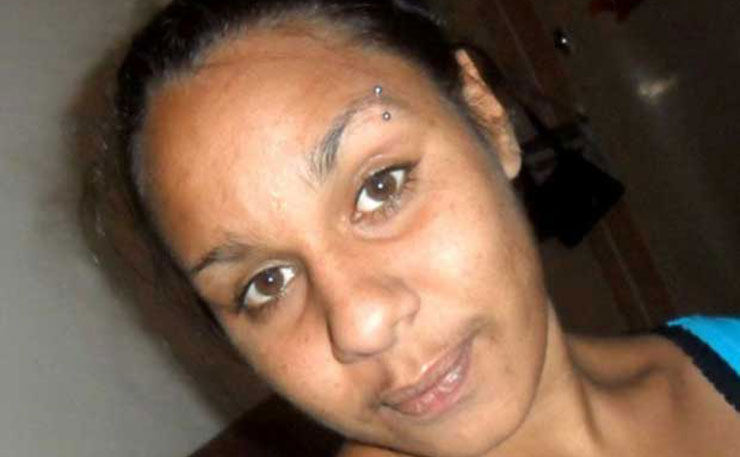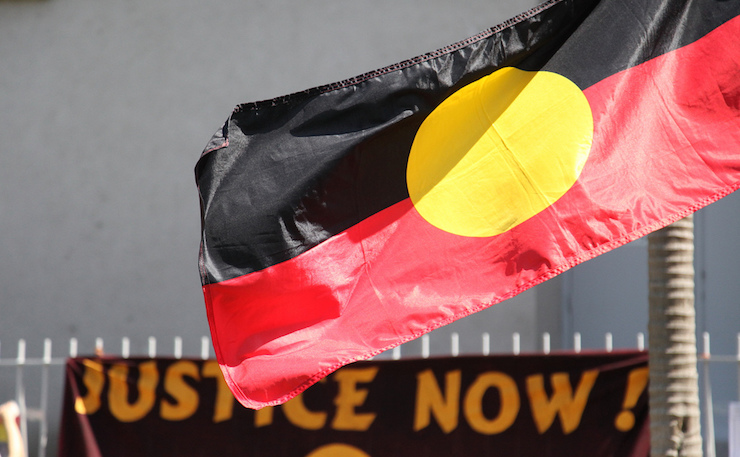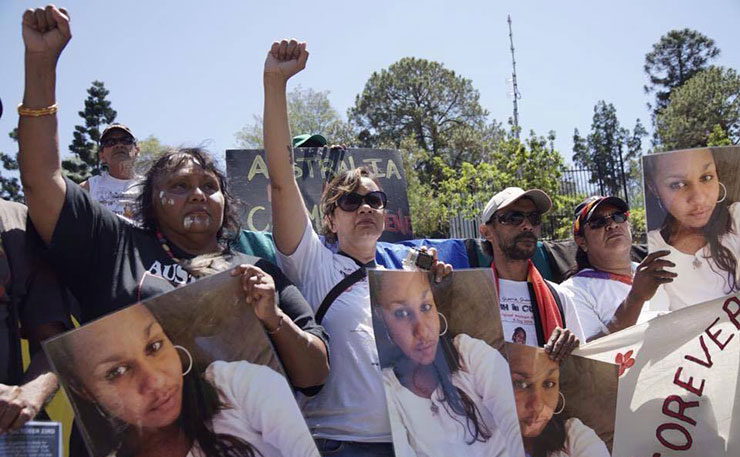After a Victorian inquiry into family violence handed down its findings last month, the state government responded boldly. On the anniversary of another Commission, one probing the incarceration of First Nations peoples around Australia, the reaction underscores an already painfully clear truth. The violence Aboriginal women face is unlike any other, writes Amy McQuire.
This is the tale of two royal commissions. One brand new, comes accompanied with optimism, the prospect of change, and is propped up by political will with the funds to back it. The other is 25-years-old today. It is burdened by broken promises and broken lives; the continuation of the lost generations. It marks an anniversary of mourning.
Late last month the Royal Commission into Family Violence handed down its report in Victoria. It comes against the backdrop of a nation attempting to come to terms with the overwhelming devastation of family violence. After eight months, thousands of submissions, and testimony from across 25 days of public hearings, the commission handed down recommendations aimed at completely reforming the state’s family violence system.
The injection yesterday of half a billion dollars in funds from the Victorian government has been met with praise. Critically, the commission paid attention to the circumstances of Aboriginal women, who are often the footnotes of reportage on family violence, despite being the most vulnerable to it. Aboriginal women are undoubtedly disproportionately impacted by family violence, and are less likely to report it.
Despite the voices of Aboriginal women being silenced for decades, their cries are slowly being heard, although it still seems no more than a whisper to Australian ears.
But at least it’s a whisper.
As we mark the anniversary of the Royal Commission into Aboriginal Deaths in Custody (RCIADIC) today we must remember how devastating it can be to ignore these voices.
The RCIADIC handed down 339 recommendations after probing 99 individual Aboriginal deaths in custody across all states and territories between January 1980 and May 1989. It was sparked by growing anger over a number of Aboriginal deaths in custody in the 80s – from the tragic death of John Pat in Roebourne, a boy who was bashed to death by off-duty police officers and who spent his last hours on the floor of the watchhouse, to Eddie Murray in Wee Waa, and Lloyd Boney in Brewarrina. It probed the tragic case of David Gundy, an innocent man who was shot in his Marrickville house during a police raid, while his young son slept in the next room. It also investigated the cases of women like Nita Blankett, who died from an asthma attack after being refused adequate medical attention.
In the lead up to the Royal Commission, there were campaigns led by the Committee to Defend Black Rights, who brought attention to the cases, fuelling suspicion of police brutality and violence. It was this concern that framed the terms of reference of the commission.
Shortly after beginning, the Royal Commission was limited by those terms of reference – they found that Aboriginal prisoners were no less likely to die in custody than white prisoners. It was the troubling, rising number of Aboriginal people in jails that was the cause of the problem. As criminologist Thalia Anthony wrote in a brilliant piece in The Conversation this week, “the commission saw the issue as twofold: problems in the criminal justice system and the reasons for Indigenous people coming into contact with that system”.
But Dr Anthony says this is a “dichotomy is false”.
It is about how Aboriginal people come into contact with the criminal justice system – “how that system defines crime, polices Indigenous people and seeks to ‘protect them’ by placing them in custody.”
They were issues picked up by the Commission itself, and most eloquently by Commissioner Hal Wooten. If you read through Commissioner Wooten’s investigations, they are haunting. He gives voice to the families and makes an attempt to understand the humanity of the victims, the underlying causes that paved the road to prison.
On the 20th anniversary of the Royal Commission, Commissioner Wooten gave a speech reflecting on the investigations.
“The question implicit in the terms of reference was: has misconduct of custodial officers caused deaths of Indigenous prisoners, and if so why has this not been detected? The question should have been: why are Aboriginals taken into custody at such stunningly higher rates than non-Aboriginals? By the time this was realised, it was politically impossible to call the death inquiries off. A hundred or so Aboriginal families and communities were convinced or highly suspicious that a loved one had been the victim of foul play or neglect.”
Commissioner Wooten wrote that the “commissioners did not find deliberate violence or brutality, but they did find a general poor standard of care of prisoners that sometimes led to death.”
But although Commissioner Wooten so beautifully wove the narrative of disadvantage and apathy that stretched from invasion to the present, and was not shy of backing away from the racism that permeates institutions and adds to rising black jailing rates, he underestimates in this sentence the reality of the violence.
Refusing to acknowledge Nita Blankett’s history of acute asthma, causing her to die before she even made it to the hospital, for example, is more than an act of neglect. This devastating failure of duty of care is an act of violence in itself, as we see in the recent tragedy of Ms Dhu, who was born three years after the Royal Commission concluded.

It is an act of violence that characterised the life of Malcolm Charles Smith, an Aboriginal man taken from his family as a young child who fell in and out of jail as a juvenile, and then again as an adult when he murdered his sister’s partner in an attempt to find acceptance from the family he had been ripped from. Malcolm Smith died by suicide in a case that shocked the nation. He ended his life with a paintbrush to the eye – an eye for an eye. The circumstances that led a young Malcolm John Smith to that ultimate act of violence were brutal, and carried out by the state. He may have held the paintbrush, but his fate was sealed by the pens of bureaucrats.
About half of the deaths in custodies investigated by the commission involved Aboriginal men who were taken from their families as children. We know that even now, many Aboriginal kids go from out-of-home care to juvenile detention, and then jail.
The Royal Commission focused predominately on young Aboriginal men – they were the most likely to go to prison and, as a consequence, a greater number of them had died.
But it did little to reflect the concerns of Aboriginal women, who were not only grappling with issues around family violence, but also of stolen children, and being locked up themselves.
The voices of Aboriginal women were completely drowned out. Aboriginal traumatologist Judy Atkinson wrote in the Indigenous Law Bulletin in 2001 on how the focus on criminology would not solve the underlying problems that lead to rising Aboriginal incarceration rates. It seemed that cases like suicide only received attention if it occurred in custody.
“In 1988, amid calls for a royal commission to investigate black deaths in prison cells and police watch houses, Aboriginal women argued that it was also important to consider the level of violence deaths of our people outside of these places,” Judy Atkinson wrote.
“… At the time we were concerned that while a death in a watch-house received frenzied media attention, a suicide on the same day, in the same community was viewed with no concern at all by the authorities.”
She argued that there was not enough thought given to how de-criminalisation of public drunkenness would affect women, without further resources directed to them to provide safe places for men with alcohol abuse issues.
“Answers to deaths in cells, high imprisonment rates, violence against women and children, and juvenile problems, will not be found in making cells suicide proof, decriminalising public drunkenness, cooling off periods of four hours in watch house cells, educating police officers and so on. The only real answers are contained in our right and ability to redefine and articulate Law, that is, the mechanisms of social organisation and social control which allowed our society to function in balance and equity to both sexes prior to 1788,” she argued.

The reason this is important is because the commission ultimately ended up investigating the violence and brutality of the colonial-settler state, which was and still is killing Aboriginal people both behind bars and outside of them.
The violence on the frontier has internalised itself in our communities: from one generation to the next, the trauma is handed down and reborn in new forms of violence, whether it be alcohol abuse, or now, family violence.
Not focusing on the impact that any recommendation would have on Aboriginal women only compounds the problem. And today, we are not just jailing Aboriginal men at rising numbers, but Aboriginal women and children too.
Aboriginal women are now the fastest growing incarcerated group in this country. A large percentage of them are also locked up for retaliating against family violence, because there are barriers put in place to get help. Many Aboriginal women are scared to approach authorities because of this lingering fear, that they will not be believed, that they will be locked up themselves, and by the shadows that black deaths in custodies cast over every Aboriginal community today.
The majority of Aboriginal women behind bars today, regardless of how they got there, are also victims of family violence, or of the child protection policies that are ripping more and more Aboriginal children away from their families.
As CEO of Sister’s Inside Debbie Kilroy has said: “Indigenous women are frequently the victims of family violence and may be stuck in a cycle between victimisation and offending. This can create dangerous situations whereby they are fearful to contact police during incidence of family violence. When police attend these incidents they may charge the women with assault, based on her attempts to defend herself. Similarly, if she has pre-existing charges which have not been resolved then she may be arrested also.”
The fact Aboriginal women in custody are more likely to have children than non-Aboriginal women means that locking them up will continue to compound the problems in communities. It has an undeniable impact on the fabric of families. Locking up women, taking away children, leads to the rising numbers of Aboriginal young men in prison – the demographic the Royal Commission focused most heavily on. Ignoring the reality of pain of Aboriginal women, hurts Aboriginal men as well.
It hurts whole communities.
We only have to look at the scars left in the wake of recent deaths in custodies, most notably by those who loved 22-year-old Yamitji woman Ms Dhu. Her life, which began after this commission ended, should have been different.
Donate To New Matilda
New Matilda is a small, independent media outlet. We survive through reader contributions, and never losing a lawsuit. If you got something from this article, giving something back helps us to continue speaking truth to power. Every little bit counts.





